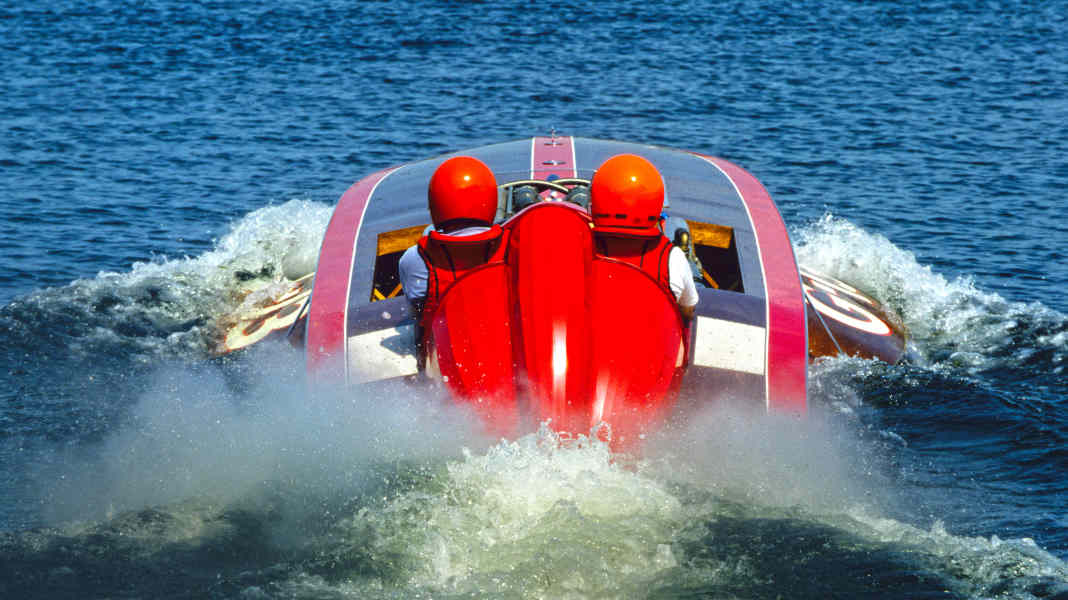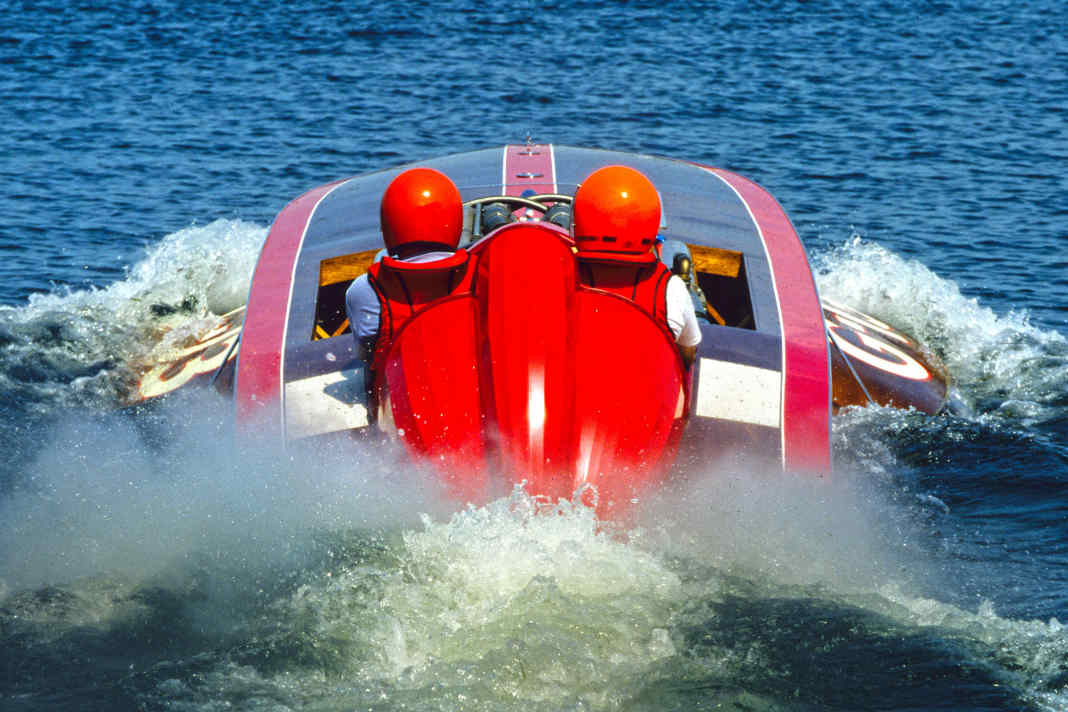
From the end of the 1930s, the American Ventnor shipyard dominated the international scene with its revolutionary "three-point hulls". These were easily recognisable by the two lateral floats on either side of the fuselage. Thanks to these "appendages" and a series of aerodynamic secrets, Ventnor boats reached speeds never before measured and won most US boat races.






At that time, rich amateurs set the tone in high-level racing boat sport. These included
Z. G. Simmons, who in 1939 ordered the varnished mahogany racing boat that would become the "Tempo VI" a few years later. For Simmons, boat racing was the pastime of a distinguished sportsman. He humorously christened his boat "My Sin", which means something like "My Sin".
His financial resources allowed him to have the impressive prototype of a Miller V16 engine with a displacement of 11 litres and an output of more than 750 hp installed. Equipped in this way, "My Sin" wins the glorious Gold Cup in 1939 and 1941, which has already been mentioned several times in BOOTE.
After the end of the war, Simmons no longer wanted to take part in big races and sold his boat in excellent condition to the New York musician Guy Lombardo, the leader of the Royal Canadian Jazz Band. He shares a special passion with Simmons: speed on the water. He took part in several races with various Ventnor racing boats with three-point hulls, all of which bore the name "Tempo".
Carried away by his success and the enthusiasm of the post-war period, Lombardo now entered the Gold Cup in the highest performance class in 1946. He slightly modified the "Tempo VI" so that he could drive it alone (his predecessor was still accompanied by a mechanic). Lombardo took charge of the race and won with a bang.
However, this victory in 1946 was the last for a boat with a highly complicated engine from the 1930s. Shortly after the end of the war, the rules were changed to allow the use of cheaper engines without limiting the cubic capacity.
Hundreds of fighter plane engines from the gigantic legacy of the Second World War come onto the market, and some racing boat pilots see this as a wonderful opportunity. For the price of a bad used car, they get a 36-litre Allison V12 that easily develops more than 1500 hp.
This means that strength and reliability are available at such a low price that the face of racing is changing.
of racing is changing. In less than a year, victory is no longer possible without the exceptional power and endurance of Allison V12s. This is further supported by the fact that numerous workshops are making these power units suitable for a wide market.
The 1947 Gold Cup was won by "Miss Pepsi V" (sponsored by a soft drink manufacturer), which flew past the entire field with its V12 aeroplane engine. Guy Lombardo at the wheel of his "Tempo VI" tries everything to keep up with his Miller engine until one of the front floats breaks off in the choppy sea. Lombardo now knows what he has to do: The Ventnor racing boat is also to be fitted with an aircraft engine.
At the beginning of the 1948 racing season, the "Tempo VI", like other racing boats, reached an output of 2000 hp. Naturally, this sudden increase leads to numerous incidents with hulls that were originally designed for half this power. The shipyards needed plenty of imagination to strengthen the structures without increasing the weight excessively.
Guy Lombardo is determined to become as famous on the water as he is on the stage and therefore undertakes a record attempt. On 25 March, he reaches a speed of 184 km/h over a distance of one land mile. The "Tempo VI" goes down in the world speed records.
It is the last heroic deed of this boat, which was born ten years earlier with an output of 750 hp. Before the end of the decade, the architecturally outdated "Tempo VI" was only at the bottom of the rankings. At the beginning of the 1950s, the boat was withdrawn from the competition and decommissioned without an engine. Its fate seemed sealed. The abandoned hull was left to decay.
A thirty-year hiatus begins for the "Tempo VI". Only the growing interest in restoring old racing boats saved her from complete destruction in the early 1980s. A family from the Seattle area set out to breathe new life into famous boats from the history of racing in the 1930s. The glorious hull of Guy Lombardo's former boat arrives at their workshop in a sorry state.
When it came to the question of which version of the "Tempo" should serve as a model, several problems arose. In order to restore the boat, a functioning Miller V16 engine was needed. However, only three of these were built and they are virtually impossible to find. So, as forty years earlier, the decision was made in favour of the V12 from Allison: available, powerful, inexpensive and reliable.
Lombardo's successors don't want boats to be displayed in a hall; they want to sail them as often as possible and take the whole family to collectors' meetings. The two-seater cockpit is being reconstructed for this purpose - the boat was only a single-seater when it was decommissioned.
After several years of hard work, the model of the 1948 world record has finally regained its radiant beauty. In 1997, the Ventnor hull with its solid panelling bolted to the structure is ready for the installation of the 1600 hp Allison V12.
Everything should be ready for the official presentation the following year - every detail is carefully attended to. The instrument panel contains all the original instruments and the profiling of the cockpit with its fine, linen-reinforced structure looks just as it did after the war. Even the paintwork is slightly glossy as it was back then, giving the "Tempo VI" a remarkable authenticity. In an environment where passion often leads to doing too much of a good thing, this is something special.
The day of the launch is another tough test for the nerves of the dedicated restorers. Although the mighty engine has run smoothly on the test bench, everything is now to work together for the first time. When the V12 engine is started, the twelve pistons give the impression of endless labour and deliberation as they slowly rise and fall in the cylinders.
But suddenly the miracle happens: the metal masses come to life in a concert of harmoniously rhythmic tapping sounds. The oldie enthusiasts listen in rapt attention to this sound. After the first few minutes have passed, the desire to push the throttle forwards to unleash this tamed power becomes almost insurmountable.
The muffled rumble of the exhaust pipes reinforces the confidence in the cockpit, which is filled with the smell of aircraft petrol and hot oil: now chasing over the surface of the water like an aircraft taking off.

